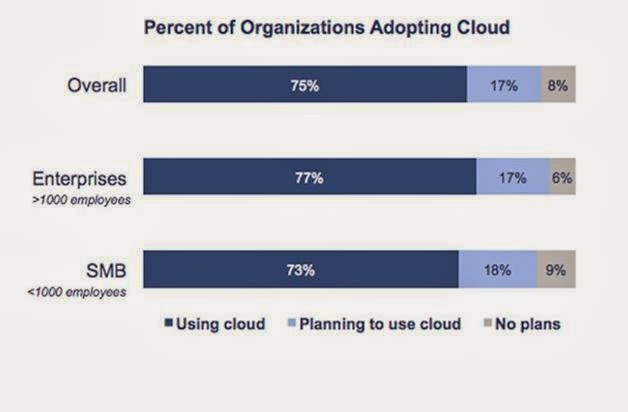
Posted by Paul Anderson
How has cloud become the SMBs’ weapon to compete with their bigger rivals?
It’s common knowledge – customers compare businesses based on the type and quality of service they provide. Service standard (how high or low it is) acts as the differentiating factor. Furthermore, Perception of good service crosses vertical lines i.e. the service offered by a company affects the customers’ interactions with other companies.
For instance, if a customer receives exceptional service from an airline, then most likely he expects the same treatment from others – bank where he holds his personal account or a retail store where he goes for monthly shopping.
In short, as a business entrepreneur, along with your competitors, you also need to match your service standard to other industries’ as well.
So is doing this really tough?
We say No! (Although it may seem so)
Before explaining how, let’s see first how the large and mid-level companies have reacted to this change of things.
Service standard as the universal parameter for companies’ across all industries had given an unfavorable edge to the BIG players of the market. They have leveraged their human resources and money to invest in more advanced service technologies.
Conversely, for the middle-sized companies, (always trying to compete with the big players) have meant – better access to infrastructure, including multichannel and cross-channel call routing and self-service.
However, with less capital to put in, the central challenge for the SMBs has been to understand what level of investment will have the most appropriate service outcome. In the lieu of investing in the right technologies to appear large, established organizations that can compete with the true heavyweight competitors – SMBs have chosen the Cloud-platform.
In the words of an expert – ‘’Cloud-based technologies has not just enabled the smaller businesses to appear as their large peers, but have also made them more flexible and agile compared to their sophisticated counterparts. They have upended the situation for small businesses by eliminating ’bigness as an advantage to win customers.’’
Source: RightScale State of the Cloud Report 2013
Experimenter – innovator – leader
With cloud as the competitive differentiator, majority of the small businesses across the globe have shifted their on-premise legacy applications to a virtualized setup. In relation to this trend, research body Ovum has defined the progression of stages that companies pass through as they migrate to cloud-based services.
Read further as we bring to you a snippet of these four stages –
1. Implementation
Being the primary stage – the main objective for companies is to migrate from heavy capital expenses to operating expenses. The lure of achieving scalability to handle seasonal fluctuations and unusual peaks in call volume is too strong to ignore. Moreover, they look forward to appear big through hiring extra agent positions which is otherwise too expense in a premise system.
Like in any new development, here too, companies start down the cloud path, examining their comfort levels. Most likely, companies find them in a see-saw mode with a mix of premise-based and cloud-based infrastructure. While they are sure of the cloud benefits, still it is difficult for them to clearly envision the way cloud will transform their customer engagement strategies.
2. Consolidation
Progressing to the second stage, companies start experiencing other key cloud benefits than just low operational costs. Elements like: shorter wait times and availability for longer hours of the day, come into the picture that inevitably elevate the satisfaction level. Stage 2 becomes the time when cloud concerns like security and reliability is put at bay and companies start contemplating future cloud based software development.
Now, the mechanism to use cloud for competing in a broader market space becomes the priority. Companies start presenting themselves as a progressive force in the market by rolling out web chat, mobile application integration etc.
3. Optimization
Implementation of advanced cloud-based tools gets discussed across the different divisions. Customer care, marketing and sales leaders, hold meetings about different cloud applications to be deployed for bringing in best improvement to customer service. As a result – new workflows and processes are designed around the cloud.
This change experienced across the organization benefits the swath of leaders in particular. In case of on-premise legacy system where constant technology management and administration was required, cloud frees from all these hassles. Leaders focus on the technology benefits experienced by the employees and customers, based on which they plan the future implementations/modifications.
Source: RightScale State of the Cloud Report 2013
4. Transformation
Stage four is the ultimate period where companies find themselves benefiting from the most advanced state of cloud. With no headache of technology deployment and replacement, they deliver seamless interactions and experiences for customers in real.
Although a few experts find this stage as too fanciful, Ovum strongly advocates it. In its opinion, smaller businesses have all the potency to reach the final stage considering it is easier for them to make cultural and process changes required for transforming customer experiences.
Final Thoughts
Considering the fact that small and medium businesses do not have the luxury of dominant market share or a deep well of resources – it only asks them to be more agile and responsive to the changing business conditions.
And this is precisely where cloud technologies fit the bill perfectly. What starts as an initiative to migrate from high capex to low opex, turns out the pathway to growth – the best way to leapfrog the competitors. Apart from the tactical advantages that cloud renders, it’s the strategic benefits that give a competitive edge to the SMBs. Not do they just keep up with the service impressions of the large MNCs but also get the capability to seize the opportunity and move forward.
